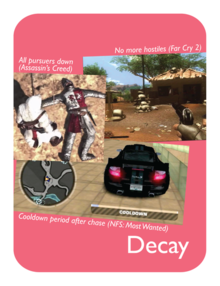Difference between revisions of "Decay"
ValterAlves (Talk | contribs) m |
ValterAlves (Talk | contribs) m |
||
| Line 18: | Line 18: | ||
[[Decay]] is a transient phase in the game's [[Emotional Script]]. Its opportunity is dictated by the [[Gameplay]] and it has a short duration. It aims at leading or supporting the player while changing from a state of high arousal (e.g. the end of an [[Engagement]]) to a state of low arousal (as [[Relaxation]]). Usually these several phases relate in a iterated sequence ([[R-A-E-D Iterations]]). | [[Decay]] is a transient phase in the game's [[Emotional Script]]. Its opportunity is dictated by the [[Gameplay]] and it has a short duration. It aims at leading or supporting the player while changing from a state of high arousal (e.g. the end of an [[Engagement]]) to a state of low arousal (as [[Relaxation]]). Usually these several phases relate in a iterated sequence ([[R-A-E-D Iterations]]). | ||
| − | A common approach is to perform a fade out in the | + | A common approach is to perform a fade out in the ongoing ([[Engagement]]) [[Music]]. Other approaches in term of [[Music]] include presenting a short piece of [[Music]] evoking "discharge", or the piece that would be the ending of the ongoing composition (if were hearing it in a non dynamic means). Other approaches using [[Entrainment]], are also interesting. Some designers also opted to explicitly informing the player about the change in arousal states through diegetic [[Dialogue]]. |
| examples= | | examples= | ||
Revision as of 18:32, 15 October 2011

|

| |
| The card's front face | The card's back face |
Contents
Synopsis
| A phase of gameplay of reestablishment after an engagement. |
Relationships
Context:
R-A-E-D Iterations ![]() , Gameplay File:M385px-Gameplay-front-v20.png, Emotional Script
, Gameplay File:M385px-Gameplay-front-v20.png, Emotional Script ![]() .
.
Peers:
Relaxation ![]() , Anticipation
, Anticipation ![]() , Engagement
, Engagement ![]() .
.
May use:
Music ![]() , Dialogue
, Dialogue ![]() , Entrainment
, Entrainment ![]() .
.
Description
Decay is a transient phase in the game's Emotional Script. Its opportunity is dictated by the Gameplay and it has a short duration. It aims at leading or supporting the player while changing from a state of high arousal (e.g. the end of an Engagement) to a state of low arousal (as Relaxation). Usually these several phases relate in a iterated sequence (R-A-E-D Iterations).
A common approach is to perform a fade out in the ongoing (Engagement) Music. Other approaches in term of Music include presenting a short piece of Music evoking "discharge", or the piece that would be the ending of the ongoing composition (if were hearing it in a non dynamic means). Other approaches using Entrainment, are also interesting. Some designers also opted to explicitly informing the player about the change in arousal states through diegetic Dialogue.
Examples





